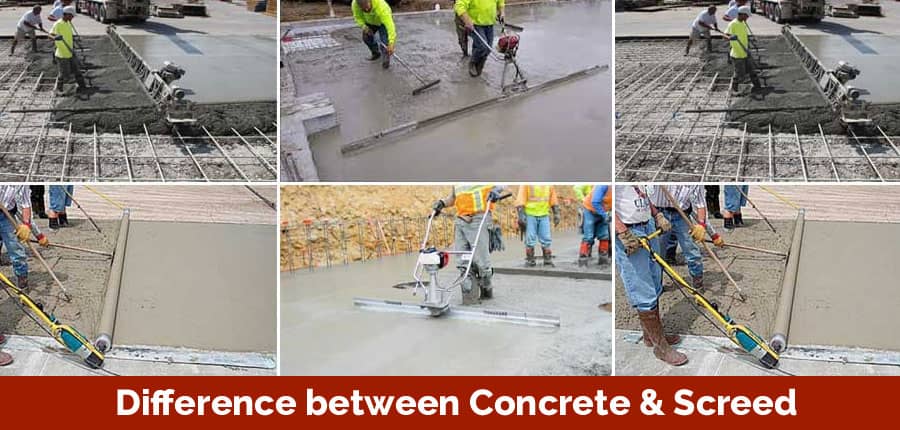Difference between Concrete & Screed

The purpose of a concrete screed is to bring the installation surface of the concrete flooring to the design height & provide a suitable base to install the specified flooring. Concrete screeds come in a variety of thicknesses. There should be sufficient rigidity in the screed.
As a result, they can resist stresses and distortions that may occur during the process of spreading and leveling the floor top. Screeds made of metal strips or pipes spaced no more than 10 feet to work effectively.
Define Concrete Screed
Screed is the process of smoothing the surfaces of concrete after it has been poured. Normally, it forms a smooth floor coating on top of a base floor and also provides a solid foundation for the top floor. In screeds, cement binders, as well as anhydrite-based binding agents, are mixed into pre-blended mortar.
Specification of Concrete Screed
Installing the specified flooring requires the substrate to behave as such. The flooring will install on schedule. The flooring will demonstrate durability in various environments.
Service conditions can be external or internal, depending on whether the flooring is for civil, commercial, or industrial use. As described above, screed is the process of removing excess wet concrete from the top of a slab so that the top surface is graded and smooth.
Features of Concrete Screed
Thickness
There is no set thickness for screed. It depends on how thick the screed needs to be, how thick the floor needs to be, and the amount of traffic that will be passing over the ground.
Mechanical Resistance
Screed used for flooring in a home must have a minimum strength of 20 MPA, while screed used in a business setting should have a strength of 30 MPA. The ultimate load imposed by the floor and the load imposed by the floor type require a certain amount of mechanical resistance.
Compactness
On the entire surface & throughout the whole thickness of the concrete screed, it must be compact & homogeneous. Layers or areas of the screed showing low consistency or malleability can be a sign of poor mechanical properties, resulting in breakage or detachment.
Concrete Screed Curing & Dimension
The screed has to be properly laid and cured before the ground can be installed. If there is any shrinkage in it, this proper curing will allow it to be finished. Screeds are vulnerable to hygrometric shrinkage during their curing cycles. This is due to the evaporation of water used in blending or during drying. The shrinkage of the screed will cause it to curl or crack and may cause the floor to separate.
Crack Free Screed
Among other factors, hygrometric shrinkage causes cracks in the concrete screed. The blend contains a great deal of water as well. Cracks can also result from very fine aggregates or excessively high cement content in the mix. Epoxy resins seal cracks with high precision. They are applied prior to the ground installation. An anti-fracture membrane should prevent hairline cracks on screed surfaces.
Clean
A clean screed surface is essential. The screed surface must be cleaned before flooring can be installed. The screed will not adhere to surfaces that are not clean.
Dry
Ensure the screed surface is moist enough by checking the residual humidity. For a floor covering of a particular type, a uniform thickness requires throughout the thickness. If your floors are sensitive to humidity, it's crucial to do this during installation. Screeds made from anhydrite must not contain more than 0.5% moisture. An electric or carbide hydrometer measures residual humidity in screeds.
Flatness
You must lay a straight, two-meter-long edge on the screed surface in all directions to check its flatness. This edge may not exceed 2 millimeters intolerance. Before installing a floor, a suitable product must level the surface if it is not within the tolerance.
Employ anticorrosive glass in environments with high humidity, such as bathrooms.
Smoothness
Floor types that are appropriate for a particular grade of finish and level of roughness usually depend on what kind of surface installs. Reflective finishes require a skimming product specifically designed for reflective surfaces.
Composition of Concrete Screed
Suitable aggregates, super plasticizers, liquid and powdered mixtures & admixtures mix in water. Specific binders are dissolved in water and mixed with aggregates.
Screeds are made by mixing aggregates on a granulometric curve. Mixing pre-blended mortars with water is the last step of concrete screed composition.
Difference between Concrete & Screed
Cement, water, and aggregate are all the ingredients for concrete and screed. It is mainly the type of aggregate which differs between the two materials.
Gravel is one of the coarse aggregates you add to concrete when mixing. A gravel stone is usually 20mm in size or smaller. By adding coarse aggregate to concrete, it becomes stronger, more durable, and more workable.
Screed does not use gravelly aggregate as concrete does. As a substitute, we use fine, sharp sand that has a maximum particle size of about 4mm. Due to this; screeds have a fine, tightly packed texture and are suitable for applying as a top layer to concrete floors.
To learn more, watch the following video tutorial.
Video Source: Civil Site visit
